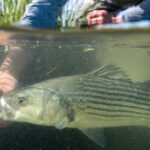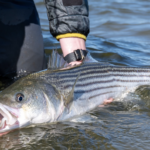
What to Watch for: ASMFC Spring Meeting
The Atlantic States Marine Fisheries Commission (ASFMC) will gather in Arlington, Virginia this week for the
By Tony Friedrich, VP/Policy Director
The Atlantic States Marine Fisheries Commission will hold their summer meeting from August 2-4. The agenda will cover several species of interest.
On the first day and probably of most interest, will be striped bass. The Board will start at 1:30 and is scheduled to go until 5 PM. Here is the link if you would like to follow along virtually. The agenda is below.
Atlantic Striped Bass Management Board Supplemental
Make sure and check the link for the supplemental materials. There are some telling details included in that document. One of the charts that jumped out to us was recreational harvest by state for 2020 and 2021. If you recall, Addendum VI to Amendment 6 required an 18% reduction in removals.
New Jersey submitted an outlandish number of conservation equivalency proposals. They also advocated and got the 18% reduction by state rather than coastwide. When the numbers came out, it was still shocking to see they overfished by 76% in 2021 instead of taking the 18% reduction that frankly wasn’t enough in the first place for NJ.
Where exactly is the accountability in all of this? The chart below shows why we pushed so hard to get rid of conservation equivalency. Imagine having the “flexibility” to manage the most important fish on the East Coast by using data in ways it was never intended to be used, overfishing a depleted stock, and having no repercussions. If you can imagine all of that, then you understand New Jersey.

Some other interesting facts came out in the supplemental materials. New Jersey and Maryland recreationally harvested 74% of the total recreational take in 2021. In comparison, Massachusetts only harvested 10% while New York came in at 8%. How much longer are we going to allow two states to consume the fishery?
Total recreational harvest (A+B1) in 2021 is estimated at 1.82 million fish (15.7 million pounds),and represents a 6% increase relative to 2020 (5% increase by weight) (Tables 9-10). New Jersey landed the largest proportion of recreational harvest in number of fish7 (42%), followed by Maryland (32%), Massachusetts (10%), and New York (8%) (Table 10). The proportion of recreational harvest in numbers from Chesapeake Bay was estimated at 35% in 2021, compared to 46% in 2020.
The final number that jumped out at us was the commercial harvest in the Chesapeake. The three jurisdictions, Virginia, PRFC, and Maryland, accounted for 81% of the total commercial harvest. Does this even begin to make sense? We aren’t so sure.
We all know that the assessment is coming out in October. One of the items on the agenda is a discussion about a timeline for response to the assessment. We aren’t sure why that is on there. That issue has already been decided with the motion from Mike Armstrong, Mass DMF. Mike initiated a motion that would allow the board to act swiftly. This motion passed. We may be reading into this too much but better to be aware of it than get broadsided.
The final thing to note about striped bass is this quote from the supplemental material.
For the 2022 review of JAIs, the analysis evaluates the 2019, 2020, and 2021 JAI values per the Amendment 7 recruitment trigger. One state (Maryland) met the criteria of the Amendment 7 recruitment trigger (Figure 8). Maryland’s JAI values for 2019 (1.95), 2020 (1.12), and 2021 (1.65) were below the Maryland JAI trigger level of 4.16. Since this trips the recruitment trigger in 2022, F reference points using the low recruitment assumption will be calculated. Because 2022 is a stock assessment year, that reference point calculation and trigger evaluation will be part of the 2022 assessment update (results expected in October 2022).
The Maryland Juvenile Abundance Index (JAI), sometimes referred to as Young of the Year (YOY) was below the trigger level. Remember when we advocated for strong triggers? This is why. Strong triggers make managers accountable for stock status.
Other meetings of interest will include menhaden, Atlantic herring, and sciaenids (drum family). As always, we will let you know what happens. Be on the lookout for a podcast and blog recap after the meeting.

The Atlantic States Marine Fisheries Commission (ASFMC) will gather in Arlington, Virginia this week for the

Consistent spawning production is paramount to a fishery’s long-term health. Many environmental factors are suspected

While the ASGA team is extremely proud of the community we’re building with the Guide

Feature Image: A false albacore being landed off Jupiter Florida by the Cheeky Fishing team,
We rely on our members and donations to keep fighting for a sustainable tomorrow in marine conservation.
By using this website, you agree to our use of cookies. We use cookies to provide you with a great experience and to help our website run effectively. To learn more, please review our privacy policy.